小学英语语法专题一:冠词
- 格式:docx
- 大小:12.98 KB
- 文档页数:3
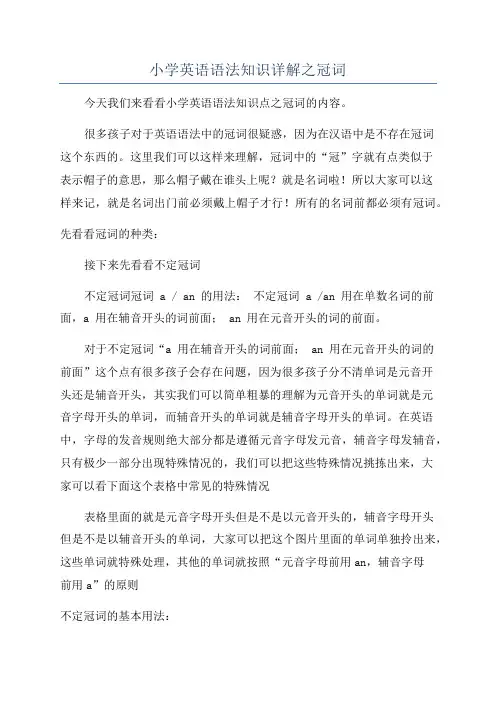
小学英语语法知识详解之冠词今天我们来看看小学英语语法知识点之冠词的内容。
很多孩子对于英语语法中的冠词很疑惑,因为在汉语中是不存在冠词这个东西的。
这里我们可以这样来理解,冠词中的“冠”字就有点类似于表示帽子的意思,那么帽子戴在谁头上呢?就是名词啦!所以大家可以这样来记,就是名词出门前必须戴上帽子才行!所有的名词前都必须有冠词。
先看看冠词的种类:接下来先看看不定冠词不定冠词冠词 a / an 的用法:不定冠词 a /an 用在单数名词的前面,a 用在辅音开头的词前面; an 用在元音开头的词的前面。
对于不定冠词“a 用在辅音开头的词前面; an 用在元音开头的词的前面”这个点有很多孩子会存在问题,因为很多孩子分不清单词是元音开头还是辅音开头,其实我们可以简单粗暴的理解为元音开头的单词就是元音字母开头的单词,而辅音开头的单词就是辅音字母开头的单词。
在英语中,字母的发音规则绝大部分都是遵循元音字母发元音,辅音字母发辅音,只有极少一部分出现特殊情况的,我们可以把这些特殊情况挑拣出来,大家可以看下面这个表格中常见的特殊情况表格里面的就是元音字母开头但是不是以元音开头的,辅音字母开头但是不是以辅音开头的单词,大家可以把这个图片里面的单词单独拎出来,这些单词就特殊处理,其他的单词就按照“元音字母前用an,辅音字母前用a”的原则不定冠词的基本用法:(1)表示其中一个人或东西,但不具体说明何人或何物。
如:There is a dog lying on the ground. (2)表示类人或事物,以区别于其他种类。
如:An elephant is much stronger than a man. (3)表示类人或事物中的任何一个。
如:He is a teacher of English.(4)表示“一”这个数量。
如:There is a table and fourchairs in that dining-room.定冠词的基本用法:定冠词 the 用在可数名词的单数或复数或不可数的名词前面。
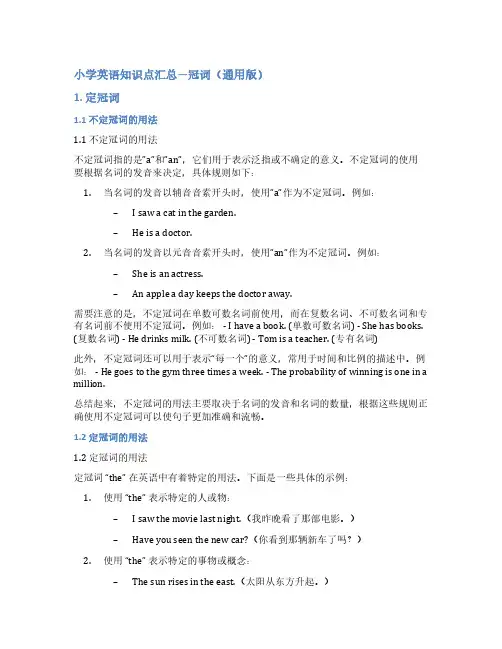
小学英语知识点汇总—冠词(通用版)1. 定冠词1.1 不定冠词的用法1.1 不定冠词的用法不定冠词指的是”a”和”an”,它们用于表示泛指或不确定的意义。
不定冠词的使用要根据名词的发音来决定,具体规则如下:1.当名词的发音以辅音音素开头时,使用”a”作为不定冠词。
例如:–I saw a cat in the garden.–He is a doctor.2.当名词的发音以元音音素开头时,使用”an”作为不定冠词。
例如:–She is an actress.–An apple a day keeps the doctor away.需要注意的是,不定冠词在单数可数名词前使用,而在复数名词、不可数名词和专有名词前不使用不定冠词。
例如: - I have a book. (单数可数名词) - She has books. (复数名词) - He drinks milk. (不可数名词) - Tom is a teacher. (专有名词)此外,不定冠词还可以用于表示“每一个”的意义,常用于时间和比例的描述中。
例如: - He goes to the gym three times a week. - The probability of winning is one in a million.总结起来,不定冠词的用法主要取决于名词的发音和名词的数量,根据这些规则正确使用不定冠词可以使句子更加准确和流畅。
1.2 定冠词的用法1.2 定冠词的用法定冠词“the” 在英语中有着特定的用法。
下面是一些具体的示例:1.使用“the” 表示特定的人或物:–I saw the movie last night.(我昨晚看了那部电影。
)–Have you seen the new car?(你看到那辆新车了吗?)2.使用“the” 表示特定的事物或概念:–The sun rises in the east.(太阳从东方升起。
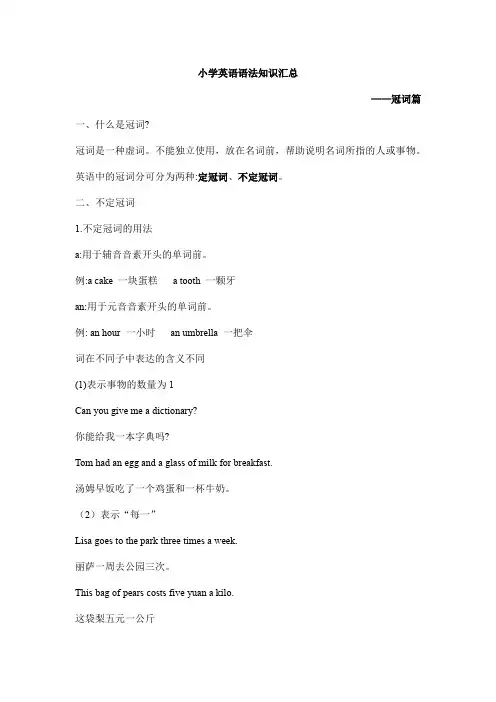
小学英语语法知识汇总——冠词篇一、什么是冠词?冠词是一种虚词。
不能独立使用,放在名词前,帮助说明名词所指的人或事物。
英语中的冠词分可分为两种:定冠词、不定冠词。
二、不定冠词1.不定冠词的用法a:用于辅音音素开头的单词前。
例:a cake 一块蛋糕 a tooth 一颗牙an:用于元音音素开头的单词前。
例: an hour 一小时an umbrella 一把伞词在不同子中表达的含义不同(1)表示事物的数量为1Can you give me a dictionary?你能给我一本字典吗?Tom had an egg and a glass of milk for breakfast.汤姆早饭吃了一个鸡蛋和一杯牛奶。
(2)表示“每一”Lisa goes to the park three times a week.丽萨一周去公园三次。
This bag of pears costs five yuan a kilo.这袋梨五元一公斤(3)一类事物A cat likes to eat fish. 猫喜欢吃鱼。
A lion can be dangerous. 狮子可能有危险性。
3不定冠词的固定用法have a cold 感冒have a bath 洗澡as a result 结果 a lot of 许多have a rest 休息have a try 尝试keep an eye on 照看 a kind of 一种三、定冠词定冠词the 有“这(那)个”的意思,可以和名词连用,表示某个或某些特定的人或东西。
Is the blue kite yours? 这个蓝色的风筝是你的吗?The woman in pink is my aunt. 穿粉色衣服的女人是我的阿姨I have a cat.The cat is black.我有一只猫,它是黑色的。
I bought a dictionary. The dictionary is very useful.我买了一本字典。
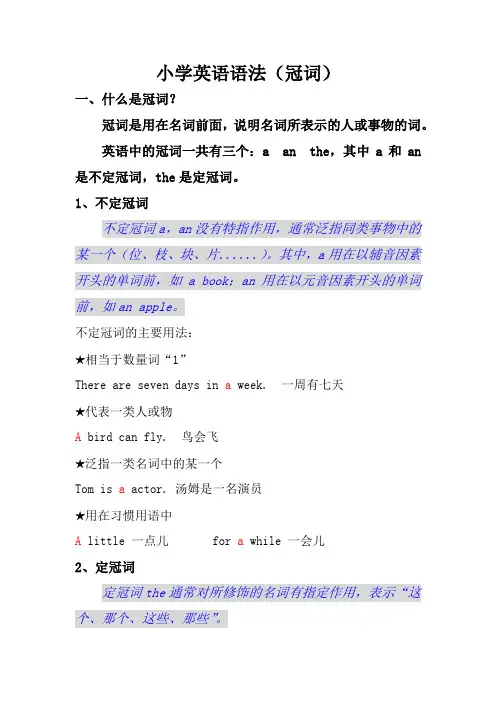
小学英语语法(冠词)一、什么是冠词?冠词是用在名词前面,说明名词所表示的人或事物的词。
英语中的冠词一共有三个:a an the,其中a和an 是不定冠词,the是定冠词。
1、不定冠词不定冠词a,an没有特指作用,通常泛指同类事物中的某一个(位、枝、块、片......)。
其中,a用在以辅音因素开头的单词前,如a book;an用在以元音因素开头的单词前,如an apple。
不定冠词的主要用法:★相当于数量词“1”There are seven days in a week. 一周有七天★代表一类人或物A bird can fly. 鸟会飞★泛指一类名词中的某一个Tom is a actor. 汤姆是一名演员★用在习惯用语中A little 一点儿 for a while 一会儿2、定冠词定冠词the通常对所修饰的名词有指定作用,表示“这个、那个、这些、那些”。
定冠词的主要用法:★用于特定的人或物前面The girl in red is my sister 穿红衣服的女孩是我姐姐★用于上文提到过的人或物I have a book.The book is on the desk.我有一本书,书在课桌上★用于世上第一无二的事物前The sun is bigger than the moon. 太阳比月亮大★用在形容词前,表示一类人The young should respece the old. 年轻人应该尊敬老年人★用在序数词、形容词最高级及形容词only、very、same等词前面。
May is the fifth month. 5月是第五个月份★用在某些由普通名词构成的国家、单位、机关团体、阶级等专有名词前The United States 美国★用在表示乐器的名词前She can play the piano. 她会弹钢琴★用在姓氏的复数名词之前,表示一家人The Whites are visiting Beijing. 怀特一家正在北京游览。
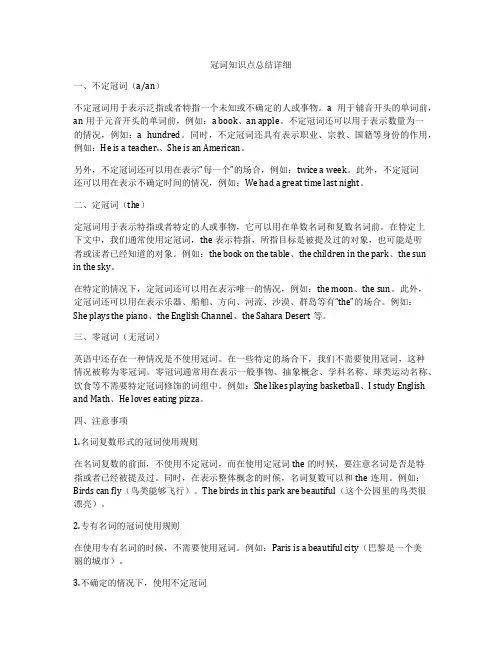
冠词知识点总结详细一、不定冠词(a/an)不定冠词用于表示泛指或者特指一个未知或不确定的人或事物。
a用于辅音开头的单词前,an用于元音开头的单词前,例如:a book、an apple。
不定冠词还可以用于表示数量为一的情况,例如:a hundred。
同时,不定冠词还具有表示职业、宗教、国籍等身份的作用,例如:He is a teacher.、She is an American。
另外,不定冠词还可以用在表示“每一个”的场合,例如:twice a week。
此外,不定冠词还可以用在表示不确定时间的情况,例如:We had a great time last night。
二、定冠词(the)定冠词用于表示特指或者特定的人或事物,它可以用在单数名词和复数名词前。
在特定上下文中,我们通常使用定冠词,the表示特指,所指目标是被提及过的对象,也可能是听者或读者已经知道的对象。
例如:the book on the table、the children in the park、the sun in the sky。
在特定的情况下,定冠词还可以用在表示唯一的情况,例如:the moon、the sun。
此外,定冠词还可以用在表示乐器、船舶、方向、河流、沙漠、群岛等有“the”的场合。
例如:She plays the piano、the English Channel、the Sahara Desert等。
三、零冠词(无冠词)英语中还存在一种情况是不使用冠词。
在一些特定的场合下,我们不需要使用冠词,这种情况被称为零冠词。
零冠词通常用在表示一般事物、抽象概念、学科名称、球类运动名称、饮食等不需要特定冠词修饰的词组中。
例如:She likes playing basketball、I study English and Math、He loves eating pizza。
四、注意事项1.名词复数形式的冠词使用规则在名词复数的前面,不使用不定冠词,而在使用定冠词the的时候,要注意名词是否是特指或者已经被提及过。
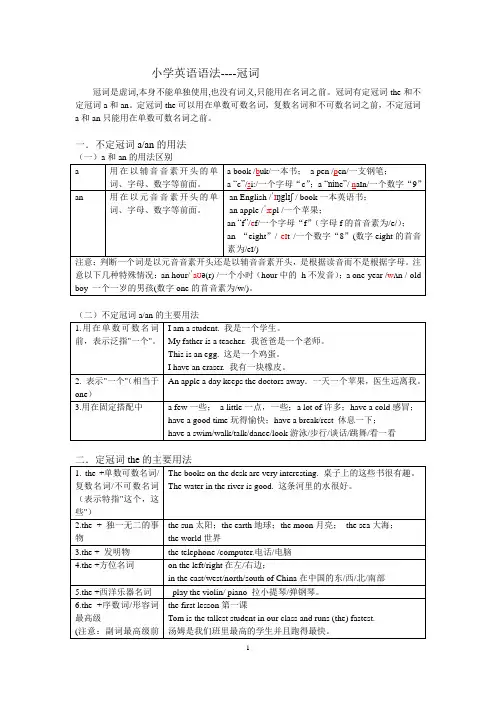
小学英语语法----冠词冠词是虚词,本身不能单独使用,也没有词义,只能用在名词之前。
冠词有定冠词the和不定冠词a和an。
定冠词the可以用在单数可数名词,复数名词和不可数名词之前,不定冠词a和an只能用在单数可数名词之前。
一.不定冠词a/an的用法练一练一.用适当的冠词填空1. Mr. Li is ____ old worker.2. Look at ____ picture! There’s ____ house in it.3. There is ______ interesting picture on ______ wall.4. Tom is ___ kind boy. All ___ students love him.5. Meimei is ___ best student in her class.6. ___ earth is one of ____ sun’s planets.7. Mary is ___ cleverer of the two girls.8. --How long did you stay there ?--About half ___ hour.9._______ Great Wall is _______ longest wall in the world.10. Shanghai is in _______ east of China.11. Beijing is _______ beautiful city.12. There is _______ old book on the desk. _______ old book is Mary’s.13.His sister likes playing ______ piano.14. She has _______ orange skirt. _______ skirt is nice.15. At that time Tom was _______ one-year-old baby.二.单句改错1.What a interesting story it is!2. Kate sometimes plays violin before supper.3.I sometimes play the table tennis after school.4. We can’t see sun at night.5. There is a “s” in the word “bus”.6. The Huanghe River is in north of China.7.A book on the desk is mine.8.I have new pen and I like it very much .9.I go to school by a bike.10. My father is an teacher.答案:一.1. an 2. the; a 3.an; the 4. a ; the 5.the 6.The;the 7.the 8.an 9. The; the 10.the 11.a 12.an; the 13.the 14.an; the 15.a二.1.a—an 2. violin之前加the 3.去掉the 4. sun 之前加the 5.a—an 6. north 之前加the 7.A—The 8. new 之前加a9. 去掉a 10.an--a。
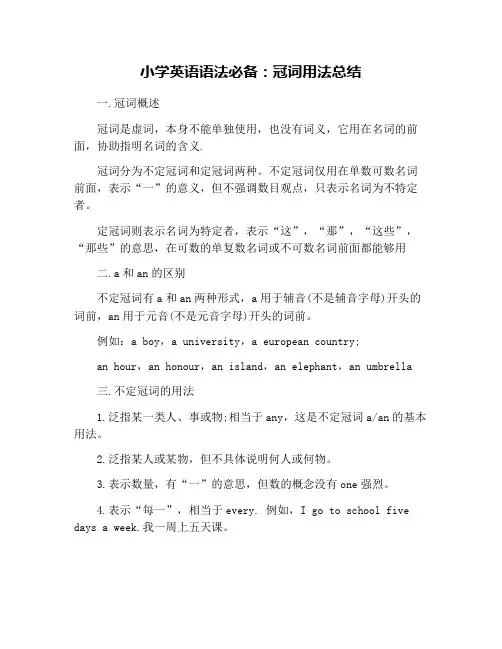
小学英语语法必备:冠词用法总结一.冠词概述冠词是虚词,本身不能单独使用,也没有词义,它用在名词的前面,协助指明名词的含义.冠词分为不定冠词和定冠词两种。
不定冠词仅用在单数可数名词前面,表示“一”的意义,但不强调数目观点,只表示名词为不特定者。
定冠词则表示名词为特定者,表示“这”,“那”,“这些”,“那些”的意思,在可数的单复数名词或不可数名词前面都能够用二.a和an的区别不定冠词有a和an两种形式,a用于辅音(不是辅音字母)开头的词前,an用于元音(不是元音字母)开头的词前。
例如:a boy,a university,a european country;an hour,an honour,an island,an elephant,an umbrella三.不定冠词的用法1.泛指某一类人、事或物;相当于any,这是不定冠词a/an的基本用法。
2.泛指某人或某物,但不具体说明何人或何物。
3.表示数量,有“一”的意思,但数的概念没有one强烈。
4.表示“每一”,相当于every. 例如,I go to school five days a week.我一周上五天课。
5.用在序数词前,表示“又一”,“再一”。
例如,I have three books. I want to buy a fourth one.我已经有三本书,我想买第四本。
6.用在某些固定词组中:a lot(of)很多,大量;after a while过一会儿四.定冠词的用法1.特指某(些)人或某(些)物,这是定冠词的基本用法。
2.指谈话双方都知道的人或事物。
例如:open the window,please.请打开窗户。
3.指上文已经提到的人或事物。
例如:I have a car. The caris red.我有一辆小汽车,它是红色的。
4.指世界上独一无二的事物。
例如:Which is bigger,the sun or the earth?哪一个大,太阳还是地球?5.用在序数词,形容词级前。
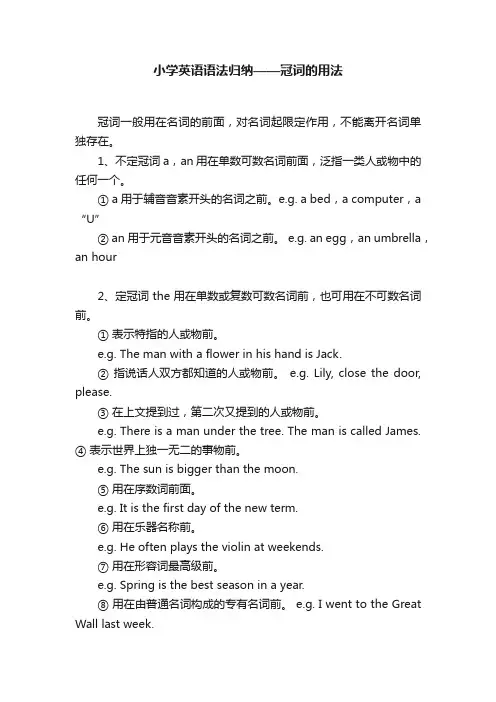
小学英语语法归纳——冠词的用法冠词一般用在名词的前面,对名词起限定作用,不能离开名词单独存在。
1、不定冠词a,an用在单数可数名词前面,泛指一类人或物中的任何一个。
① a用于辅音音素开头的名词之前。
e.g. a bed,a computer,a “U”② an用于元音音素开头的名词之前。
e.g. an egg,an umbrella,an hour2、定冠词the用在单数或复数可数名词前,也可用在不可数名词前。
① 表示特指的人或物前。
e.g. The man with a flower in his hand is Jack.② 指说话人双方都知道的人或物前。
e.g. Lily, close the door, please.③ 在上文提到过,第二次又提到的人或物前。
e.g. There is a man under the tree. The man is called James.④ 表示世界上独一无二的事物前。
e.g. The sun is bigger than the moon.⑤ 用在序数词前面。
e.g. It is the first day of the new term.⑥ 用在乐器名称前。
e.g. He often plays the violin at weekends.⑦ 用在形容词最高级前。
e.g. Spring is the best season in a year.⑧ 用在由普通名词构成的专有名词前。
e.g. I went to the Great Wall last week.⑨ 用在国家名称的缩写前。
e.g. He is from the UK.3、零冠词:名词前不用冠词的情况。
在季节、月份、星期、节假日、三餐、球类或棋类运动前,通常不用冠词。
e.g. have breakfast ,play basketball,play chess小学英语:小学英语考试分析,小学英语试题分享,提供小学英语同步学习知识点解析,学习资讯,关注我们,小学英语学习不再无助!。
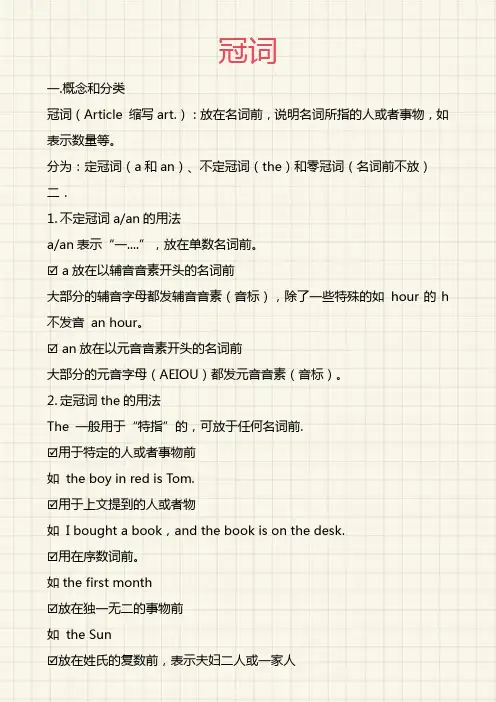
冠词一.概念和分类冠词(Article 缩写art.):放在名词前,说明名词所指的人或者事物,如表示数量等。
分为:定冠词(a和an)、不定冠词(the)和零冠词(名词前不放)二.1.不定冠词a/an的用法a/an表示“一....”,放在单数名词前。
☑ a放在以辅音音素开头的名词前大部分的辅音字母都发辅音音素(音标),除了一些特殊的如hour的h 不发音an hour。
☑ an放在以元音音素开头的名词前大部分的元音字母(AEIOU)都发元音音素(音标)。
2.定冠词the的用法The 一般用于“特指”的,可放于任何名词前.☑用于特定的人或者事物前如the boy in red is Tom.☑用于上文提到的人或者物如I bought a book,and the book is on the desk.☑用在序数词前。
如the first month☑放在独一无二的事物前如the Sun☑放在姓氏的复数前,表示夫妇二人或一家人如the Greens 格林一家☑用在形容词only very same 前。
如the only one☑用在由普通名词构成的专有名词前The Great Wall☑用在乐器前如play the guitar☑用在形容词前,表示一类人。
如the poor 穷人☑用在形容词/副词最高级前如the most beautiful girl3.零冠词(1)在表示几节、月份、星期等名词前不用冠词。
如in summer(2)国家、城市名、地名、人名等专有名词前通常不用。
如Beijing(3)表示三餐、球类运动、棋类运动和学科名称的名词前不用。
如have breakfast(4)不可数名词前不放冠词,表示一般的泛指。
如Water is very important.(5)复述名词前不放,表泛指如We are all good boys.(6)在称呼或职位前、官衔前,不放。
如Sir,are you OK?(7)两个或者两个以上的名词并用时,省去冠词。
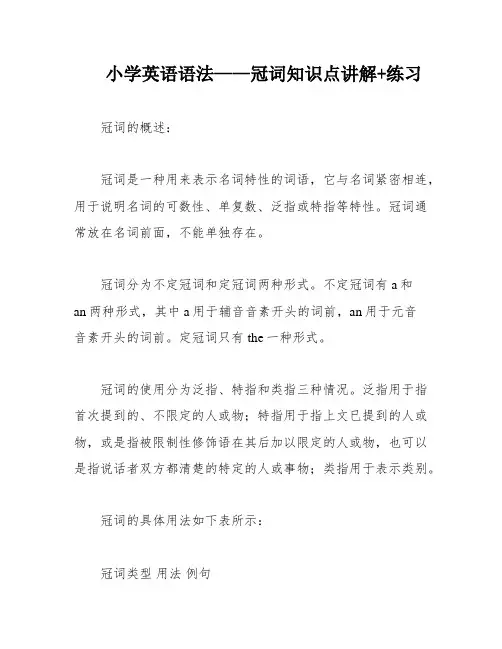
小学英语语法——冠词知识点讲解+练习冠词的概述:冠词是一种用来表示名词特性的词语,它与名词紧密相连,用于说明名词的可数性、单复数、泛指或特指等特性。
冠词通常放在名词前面,不能单独存在。
冠词分为不定冠词和定冠词两种形式。
不定冠词有a和an两种形式,其中a用于辅音音素开头的词前,an用于元音音素开头的词前。
定冠词只有the一种形式。
冠词的使用分为泛指、特指和类指三种情况。
泛指用于指首次提到的、不限定的人或物;特指用于指上文已提到的人或物,或是指被限制性修饰语在其后加以限定的人或物,也可以是指说话者双方都清楚的特定的人或事物;类指用于表示类别。
冠词的具体用法如下表所示:冠词类型用法例句不定冠词泛指单一、每一、任一事物 a(n) A book is on the table。
类指类别 A XXX can fly。
定冠词上文提到过的人或事物 The boy is in the classroom。
特指被限制性修饰语所限定的人或事物 XXX。
说话双方都清楚的人或事物 XXX。
世上独一无二的事物 XXX。
类指类别 XXX。
零冠词名词前泛指人或事物 Cats are cute。
类指类别 XXX。
冠词考点纵览:冠词的考点主要包括不定冠词a/an的用法、泛指和特指的区别、类指的使用等。
具体例题如下:考点一:不定冠词a/an的用法1) This is a book。
这是一本书。
2) There is a boy in the classroom。
教室里有一个男孩。
3) That XXX。
那是一个书包。
考点二:泛指人或事物的某一类别,以区别于其他种类。
1) A plane is a machine that can fly。
飞机是一种能飞的机器。
2) A tiger XXX 老虎可能会很危险。
3) A horse is XXX。
马对人类有用。
考点三:泛指某人或某物。
1) A girl is waiting for you。
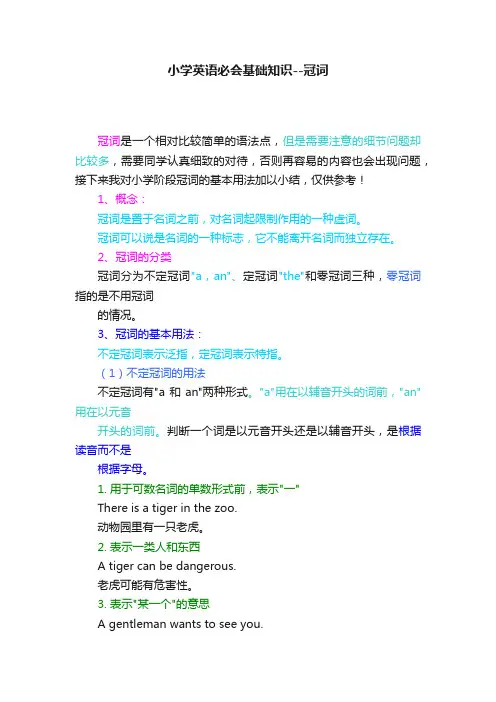
小学英语必会基础知识--冠词冠词是一个相对比较简单的语法点,但是需要注意的细节问题却比较多,需要同学认真细致的对待,否则再容易的内容也会出现问题,接下来我对小学阶段冠词的基本用法加以小结,仅供参考!1、概念:冠词是置于名词之前,对名词起限制作用的一种虚词。
冠词可以说是名词的一种标志,它不能离开名词而独立存在。
2、冠词的分类冠词分为不定冠词"a,an"、定冠词"the"和零冠词三种,零冠词指的是不用冠词的情况。
3、冠词的基本用法:不定冠词表示泛指,定冠词表示特指。
(1)不定冠词的用法不定冠词有"a和an"两种形式。
"a"用在以辅音开头的词前,"an"用在以元音开头的词前。
判断一个词是以元音开头还是以辅音开头,是根据读音而不是根据字母。
1. 用于可数名词的单数形式前,表示"一"There is a tiger in the zoo.动物园里有一只老虎。
2. 表示一类人和东西A tiger can be dangerous.老虎可能有危害性。
3. 表示"某一个"的意思A gentleman wants to see you.有一位先生要见你。
4. 表示"同一"的意思They are nearly of an age.他们几乎同岁。
5. 表示"每一"的意思We go swimming four times a week.我们每周去游泳四次。
6. 用在作表语的单数可数名词前,表示身份、职业My mother is a teacher.我妈妈是教师。
7. 在英国英语中,以"h"开头的多音节词,如第一个音节不重读,其前用"an"There is an hotel near here.这附近有一家旅馆。
冠词一.冠词的种类冠词用于名词之前, 是说明名词所表示的人或事物的一种虚词, 不能离开名词单独存在。
冠词有不定冠词、定冠词和零冠词三种形式。
不定冠词包括a和an, 用于单数可数名词前, 表示泛指, 说明名词的名称和种类, 意思是“一”。
a和an的意义和作用是一样的, 但用法不同, a用在以辅音音素开头的单词前, an 用在以元音因素开头的单词前。
练习一.在下列各词前填上a或an。
5. 1.__________.tre...2.__________ca.... 3.________pupi...4._______pictur.6.____________bee 6._________rabbit7.__________apple8.________arm9._________kitchen 10._________dog 11._________orange在横线上填上a或an, 不需要填的地方画“/”。
1._________in.bottl....2.__________orang.ba.....3.__________Englis.boy4._________red coat5.___________nice milk6.__________art lesson7._________old man8.__________cold water9.__________big apple 10._________small glass 11.________beautiful girl 12._________long river1.按需填入the, 不需要的地方画“/”。
2.What colour is _________ your dress?--It’s white.3.This is __________Jack’s pen.That is __________my pen.4.--Is ________ ice cold?--Yes,it is.5.They are _______ pupils of ________this school.They are in _________ Class one.6.It’s a fine day.We can see _______sun in the sky.7.There is an orange on_________ table.8.We go to ________ school in _________ morning.9.This is _________ Huangpu Park .It’s near __________Huangpu River.10.We like sports.We like playing __________ football best.11.They go to ___________Summer Palace on _________Sundays.四.改错题。
六年级知识点冠词冠词是英语语法中的一种词类,用来限定名词的用法。
在六年级的学习中,掌握冠词的正确用法对于学习英语至关重要。
本文将介绍六年级所需掌握的冠词知识点,帮助学生们更好地理解和运用冠词。
一、定冠词定冠词是表示特指的冠词,包括"the"。
它的用法如下:1. 特指某人或某物时,用"the"。
例如:I saw the boy who won the race.2. 特指某类人或物时,用"the"。
例如:The sun is hot in summer.3. 特指上文提到的人或物时,用"the"。
例如:I have a dog. The dog is black.4. 特指某个国家、地区或建筑物时,用"the"。
例如:The Eiffel Tower is in Paris.二、不定冠词不定冠词是表示不特指的冠词,包括"a"和"an"。
它们的用法如下:1. 表示一个人或一件事物时,用"a"或"an"。
"a"在辅音音素(以除a、e、i、o、u以外的字母开头的单词)前使用,"an"在元音音素(以a、e、i、o、u开头的单词)前使用。
例如:I have a pencil. She is an honest girl.2. 表示职业、国籍、宗教等身份时,用"a"或"an"。
例如:He is a doctor. She is an American.三、零冠词有些名词在特定情况下不需要使用冠词,称为零冠词。
主要有以下几种情况:1. 专有名词通常不需要冠词。
例如:Tom is my friend.2. 表示学科、运动等的名词一般不需要冠词。
例如:I like playing basketball.3. 用复数形式表示一般概念或抽象概念时,也不需要冠词。
英语语法《冠词的易混用法》知识点
以下是《冠词的易混用法》的知识点:
1. 定冠词 "the":用于特指人或物,是唯一的或已被提及的人或物。
例如:I saw the dog in the park yesterday.(昨天我在公园看见了那
条狗。
)
2. 不定冠词 "a" 或 "an":用于泛指人或物,没有特定的人或物。
"a" 用于以辅音音素开始的词前,而 "an" 用于以元音音素开始的词前。
例如:I want to buy a pen.(我想买一支钢笔。
)
3. 不使用冠词:有些情况下,英语中不需要使用冠词。
例如:I am student.(我是学生。
)这种情况下,学生不需要冠词。
4. 冠词的用途:冠词主要用于限定名词,可以给名词指定特定或泛
指的含义,也有时用于修饰形容词和副词的最高级。
例如:The book on the table is mine.(桌子上的那本书是我的。
)He is the tallest
boy in the class.(他是班上最高的男孩。
)
需要注意的是,冠词的使用也会受到语境、习惯用法以及独立选择的
干预。
因此,在具体的语境中,可能存在一些特殊用法或例外。
掌握冠词
用法需要通过阅读和实践来提高。
pep英语六年级上册语法专题——冠词专项PEP英语六年级上册语法专题——冠词专项一、冠词的定义冠词是一种辅助词,放在名词的前面,用来限定或加强名词的词。
二、冠词的分类1. 定冠词the定冠词the表示特指,用于表示上文或下文中已经提到的事物或具体的人。
2. 不定冠词a/an不定冠词a/an表示泛指,用于表示任何一个或一类事物,或未提及过的人。
三、冠词的用法1. 定冠词the的用法1. 表示已提到过的人或事物,或者在上下文中特指某一个人或事物。
2. 表示一类人或事物中的某一特定部分。
3. 表示惯用语、固定搭配和常规短语。
4. 特指由“形容词+名词”构成的专有名词。
5. 特指世界上独一无二或独步天下的事物。
6. 特指序数词或官衔前的人名。
2. 不定冠词a/an的用法1. 表示一类事物中的任何一个或某一类或任意一个。
2. 表示数量为“一个”。
3. 特指某一职业或身份。
4. 表示在分母位置或介词后的一类数目。
四、练题1. - ______ car over there is my sister's.- Is it ______ new car?A. A; theB. A; aC. The; theD. The; a【答案】B。
2. There is ______ country between China and Russia.A. theB. aC. anD. /【答案】D。
3. - Excuse me, can I borrow ______ pencil?- Sorry, I don't have ______ one.A. a; aB. a; oneC. one; aD. one; one【答案】A。
4. The woman with ______ hat is my English teacher.A. aB. anC. theD. /【答案】A。
5. - Is this ______ book?- No, it's ______ pencil case.A. a; aB. a; theC. an; theD. an; a【答案】D。
小学英语语法——冠词知识点讲解+练习冠词一、冠词的概述1、冠词的定义:冠词是用来表示名词特性的一种词,它表示名词可数还是不可数、单数还是复数、任何一个还是特定的一个等。
也就是说,冠词与名词是紧密连在一起的。
冠词主要放在名词之前,说明名词所表示的人或物,它不能离开名词而单独存在。
2、冠词的种类:(1)不定冠词:有a/an两种形式。
“a”用在以辅音音素开头的词前,“an”用在以元音音素开头的词前面。
判断一个词是以元音音素开头还是以辅音音素开头,是根据读音而不是根据字母。
(2)定冠词:只有the一种形式。
3、冠词的泛指、特指和类指的用法:(1)泛指:指首次提到的、不限定的人或物。
(2)特指:指上文已提到的人或物,或是指被限制性修饰语在其后加以限定的人或物,也可以是指说话者双方都清楚的特定的人或事物。
(3)类指:表示类别4、冠词的用法:概述冠词用法说明泛指单一,每,任一事物a(n)单数可数类指类别名词前一上文提到过的人或事物般要用冠特指被限制性修饰语所限定的人或事物词the说话双方都清楚的人或事物世上独一无二的事物类指种别上文提到过的人或事物复数可数特指被限制性修饰语所限定的人或事物the名词、不可说话双方都清楚的人或事物数名词前泛指人或事物零冠词类指种别二、冠词考点纵览考点1:用于第一次提到的或人或某物之前。
1考点一:不定冠词a/an的用法(1) This is a book.这是一本书。
(2) There is a boy in the classroom.教室里有一个男孩。
(3) That XXX.那是一个书包。
考点2:泛指人或事物的某一类别,以区别于其他种类。
(1) A plane is a machine that can fly.飞机是一种能飞的机器。
(2) A tiger XXX大概会很风险。
(3) A horse is XXX.马对人类有用。
考点3:泛指或人或某物。
(1) A girl is waiting for you.一个女孩正在等你。
冠词
一.定义:冠词是用在名词前面,说明名词所表示的人或事物的词。
名词是秃子,需要戴
帽子,帽子就是冠词。
二.分类:不定冠词a/an,定冠词the,零冠词
第一节a(n)的用法
用法口诀:一个,一类,某一,另一,不见原因(元音)不施恩(n)。
解析:
(1)表示数量,有"个"的意思,eg: There are 7 days in a week.
(2)表示一类人或者是物,eg: A bird can fly.
(3)泛指一类名词中的某一个,eg: Tom is an actor.
(4)用于序数词”前表另一”
例如: He have been to Beijing twice. I want to go to Beijing a third time.
提示:a third time :又一次,再一次the third time :第三次
⑸ 元音因素前要用不定冠词an : an apple an interesting book
(6)用于某些固定搭配中:
a lot of, a few, a little, a number of, after a while (不肖后),give s
b a hand (帮助某人),in a hurry, half an hour, want a go = have a try, catch (have )a cold (感冒), have a bath/shower, have a drink, have a fever (发烧),have a rest, in a /one word (总之),have a word with sb (和某人谈话), give a lesson (教课)
三.特殊用法
1.在26个字母中,当以下12个字母单独出现时,其前要用an .它们是:
/ e/: f, l, m, n, s, x (共 6 个)/ei/: a ,h (共 2 个)
/ i:/: e /a:/: r /?u/: o /ai/: i
a, e, i, o, f, h, l, m, n, r, s, x / 共12 个。
为了记忆,把它们编成一个口诀:Mr. Li has one fox.
例如: There is an " s " in the word " six ".
2.特殊单词首字母的发音:
1“h”注意以下以h开头的单词用an,因为h在此处不发音。
eg: an hour an honor (荣誉) an honest boy (——位诚实的男孩)
2“u”分两种情况:(单词以u开头)
当字母u 发/ju:/时,前面用 a.例如:a university; a useful book; a uniform(制服),a unit (单元)当字母u 发/?/时,前面用an.例如:an uncle; an umbrella; an ugly duckling (丑小鸭)解析:虽是元音字母开头,但要考虑的是元音音素。
应根据情况而定。
3one 前应用 a. There is a one-leg table. 解析:因为发/w /音。
用 a.
定冠词" the
、友日:
1.在辅音音素前读:/e?/: eg: the book.
2.在元音音素前发生音变,读:/ ei:/ (重读)或/ ei/ (弱读)
例如:in the afternoon/evening, the old man, the other one
、八大用法:
口决:特指双方熟悉,上文已经提及;
世上独一无二,序数词最高级;
某些专有名词,习语以及乐器;
形容词前表一类,姓氏复数表一家。
”
解析:1.特指双方熟悉:(说话双方均知道白^那个人或物)
例如:Where is the math teacher? He is over there.
3.上文已经提及:I have a pen. The pen is red.
也符合:第一次提到泛指用a/an,再次提到特指用the
4. 表世上独一无二 ":The sun is rising. the world, the moon, the earth;
5.在序数词,形容词最高级前:
I am the first to get to school. He is the tallest boy in our school.
6.某些专有名词:由普通名词构成的专有名词:
词组:
the Yellow River (黄河),the Summer Palace (颐和园),the United States(美国),the People ' s Republic of Chin*华人民共和国工the Children ' s POOceJ )
7.习语以及乐器:
部分习惯用语中n.前常加the :
all the time (一直),at the age of (在…岁时),all the same (仍然),at the moment (此刻), do the shopping/washing/买衣服/洗衣服,by the way (顺便说),in the morning,
in the open air(在户外),in the east/west/south/north
乐器前必加the:
口决:打球下棋者衣冠不整,演奏乐器者衣冠整齐”
例如:play football , play chess 但:play the piano play the violin
补充:西洋乐器前加the,但是中国本地的不用。
例如:play Erhu Key: /
8. the + (部分)adj.表:二类人":
例如:the poor/rich/old/young/sick/blind/new/dead
9. the +姓s表:夫妇俩,一家人”
例如:The Smiths(=The Smith family) are having lunch. (Smith 一家)
零冠词
用法口决:下列情况应免冠,代词限定名词前;
专有名词不可数,学科球类三餐前;
复数名词表泛指,两节星期月份前;(节日、季节)
颜色语种和国名,称呼习语及头衔。
解析:(1)代词”限定名词”前:
当名词前面有代词”修饰时,不用冠词。
例如:He is our Math teacher o(our 把 a 顶掉)
(2)专有名词“不可数”:
专有名词:单个国名,人名,地名。
例如:China, India, England等前不加任何冠词。
但the United States, the Great Wall是由普通名词构成的专有名词“前必加the。
不可数名词前一般不加冠词,但表特指时加定冠词the。
(3)学科”球类“三餐”前;
学科前不用the:例如:Do you like Maths? Key: /
球类前不加the: play +球不用the;(而:play the +乐器)
三餐前不用the: have lunch 但当三餐前有修饰语时,常用a/an :
例如:have a big good (nice, light ) lunch
(4)复数名词”表泛指:(必定是可数名词)
例如: Horses are useful animals. = A (The) horse is a useful animal.
注意:当泛指人类”时,常用Man来表示。
例如:Man can ' t live without(有)water or air.没有水和空气人类就不能生存。
(而不用the man 或 a man.)
(5)两节(节日、季节)“星期“月份”前;
以day组成的节日前不用the:
例如:Children ' s;DMother ' s DayMid — Autumn Day
不以Day结尾的节日前加the :
例如:the Spring Festival , the Mid -Autumn Festival ; the New Year 等季节前——般不力口the:例如:in spring /summer/ autumn(fall) /winter
但是in the spring of 1992 (当有修饰语或特指时可以加the )
On Sunday. In May.
(6)颜色“语种“和国名”:
例如:The book is red. English is a useful language. China is a big country.
⑺称呼“习语”及头衔”.
称呼:Mr. Wang is waiting for you. Here it is, Mom!
习惯用语:by + 工具:by bike/ bus/air/plane/train/ship 等。
词组:be at school , be at work, be in hospital (住院),by mistake (错误地),at night, here and there(至U处), day and night, on time, at home,
on duty, go home, go to bed, be in trouble
头衔前不加冠词:例如:Doctor (头衔),I have a headache .。